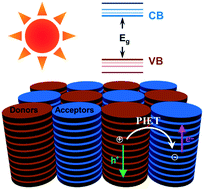A bicontinuous donor–acceptor hybrid heterostructure based on coordination and cation–π interactions†
Abstract
Donor–acceptor heterostructures have attracted much interest in current optoelectronic technologies because they can control the charge dynamics in these applications. To improve the charge-carrier generation and transport properties, the donor and acceptor components in the heterostructures have a better interface at the molecular level with bicontinuous structures. So far, most available examples are obtained by a self-assembly approach from two organic semiconducting molecules. Considering the complementary properties of inorganic and organic semiconductors, the self-assembly of semiconductive inorganic and organic components in one material is anticipated to form abnormal hybrid heterostructures with synergetic properties. However, so far, only a few such hybrid heterostructures have been reported, most of which involved in the inorganic components as electron donors. Herein we reported that the combination of 2,5-bis-(4-pyridinium)thiazolo[5,4-d]thiazole (Py2TTz) with Cu2+ in the presence of acetonitrile by a solvothermal method led to a novel bicontinuous hybrid heterostructure [Cu2(Py2TTz)(CN)2]·0.5(Py2TTz) (1) with semiconducting Py2TTz and in situ synthesized CuCN as the electron donor and acceptor components. Due to the strong coordination combined with cation–π interactions between the two semiconducting components, this hybrid exhibits enhanced photocatalytic activities towards the degradation of methylene blue (MB), rhodamine B (RhB), and methyl orange (MO) in comparison with those of the two individual bulk semiconductive Py2TTz and CuCN.



 Please wait while we load your content...
Please wait while we load your content...